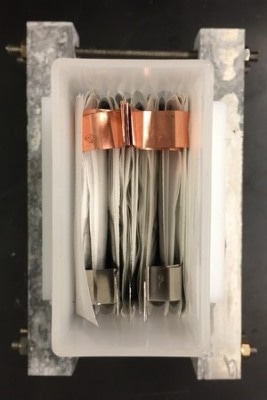Aug 2 2017
The newest innovation from The City College of New York-based CUNY Energy Institute is a new generation of manganese dioxide-zinc batteries with unparalleled cycle life and energy density. The discovery has made the regular household battery suitable for large grid storage applications.
 A look inside the energy density manganese dioxide-zinc battery developed at CCNY. (Credit- The City College of New York-based CUNY Energy Institute)
A look inside the energy density manganese dioxide-zinc battery developed at CCNY. (Credit- The City College of New York-based CUNY Energy Institute)
City College Senior Research Associate Gautam G. Yadav and his team used a new twist on the old chemistry underlying the batteries. The result is a battery that exploits intercalation and complexation chemistry to make the cathodes rechargeable to a greater extent, significantly prolonging its life.
A new layered crystal structure of manganese dioxide is used in this chemistry, which is intercalated with copper ions. This makes it rechargeable to its theoretical capacity for a significant number of cycles.
Gautam G. Yadav, Senior Research Associate, The City College of New York
According to Yadav, this is the first time a novel calcium hydroxide interlayer is used to block the toxic zinc ions through complexation. This in turn permits the battery to maintain its high energy density for more than 900 cycles.
A current trend in the energy storage field has been to swap risky and expensive lithium-ion batteries with zinc-anode varieties as zinc is inexpensive, plentiful and a lot safer. So far, the only disadvantage of this version has been the latter’s comparatively short cycle life, which has not permitted it to be successfully commercialized as a rechargeable battery.
The Yadav team’s research has been published in the Journal of Materials Chemistry A.
Team members included Xia Wei, Michael Nyce, Jinchao Huang, Joshua Gallaway, Damon Turney, Jeff Secor and Sanjoy Banerjee, Distinguished Professor and Director of the CUNY Energy Institute.